Free Poker Odds Calculator
Welcome to our comprehensive poker odds calculator! Whether you’re playing Texas Hold’em, Omaha or 7 Card Stud, our online poker probability calculator will help you understand your chances of winning. Try it for free and enhance your poker strategy today! Below we list all the options our calculator offers, along with step-by-step instructions on how to use it at the poker table.
- Hold’em
- Omaha
- Omaha H/L
- 7-Stud
- 7-Stud H/L
- Razz

What Is an Online Poker Odds Calculator
The online Texas Hold’em Poker Odds Calculator is a tool designed to help poker players determine their chances of winning the hand. By entering different scenarios, you can calculate the odds of you winning in different outcomes, which makes it easier to make decisions during the game. This tool is indispensable for both beginners and experienced poker players who want to improve their gameplay and strategy.
How to Use the Poker Odds Calculator
Using the odds calculator to play poker is very simple. To get started, study the guide below and follow these steps:
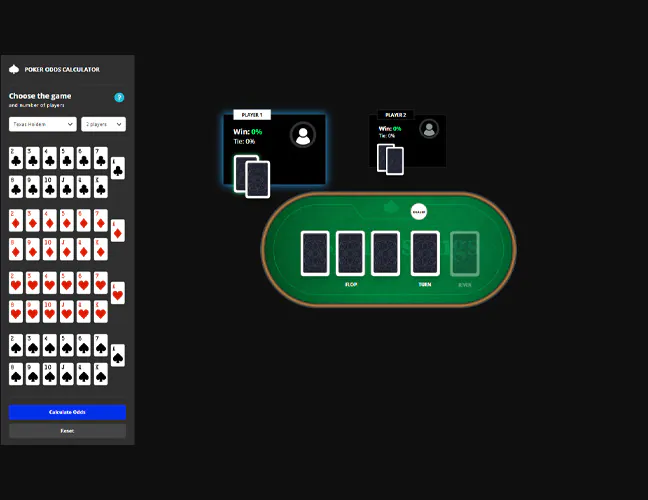
Go to the Pokerlistings website and open the calculator on your device.
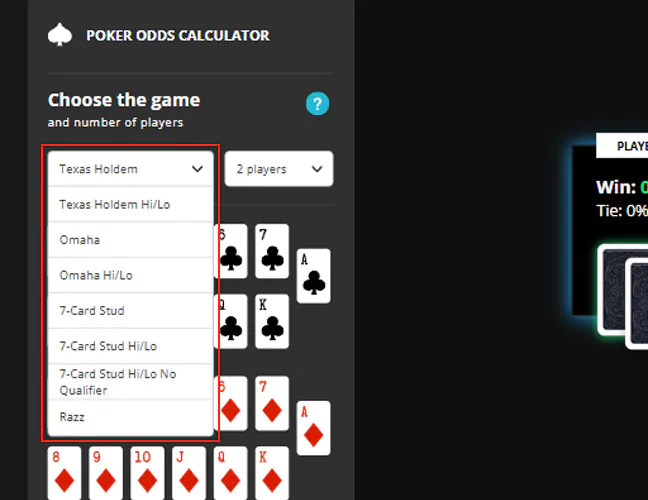
Choose one of the available game types (Texas Holdem, PLO, Razz, etc.).
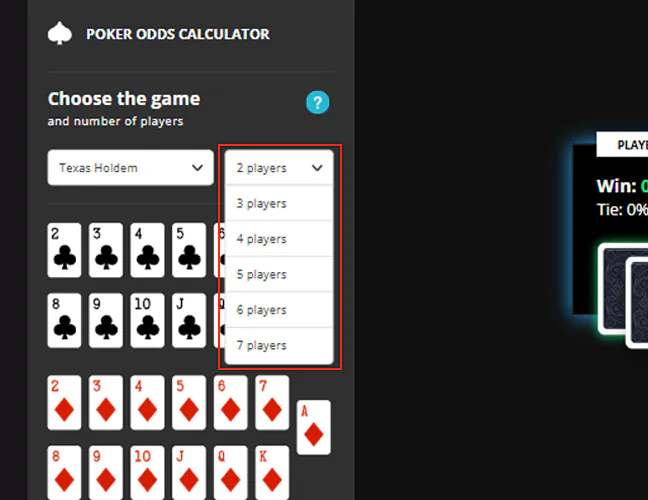
Specify how many players must be at the poker table to calculate the odds.
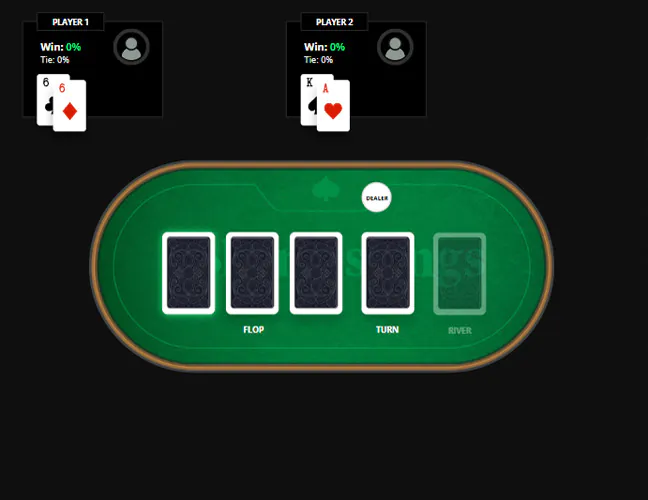
Fill in each player’s poker hands, including your own.
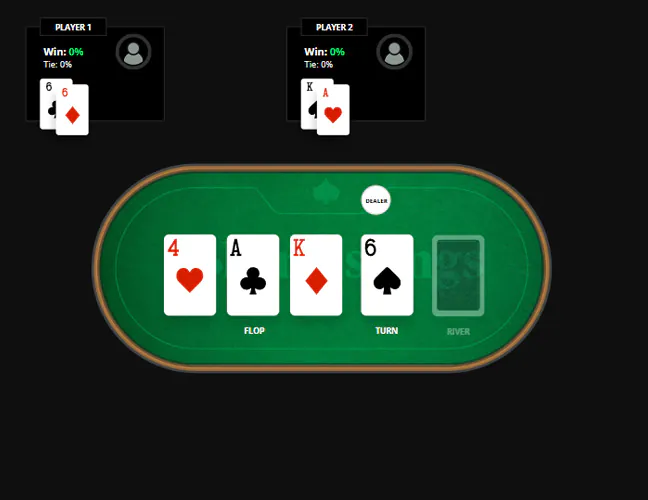
For games like Texas Hold, add Flop, Turn, and River cards.
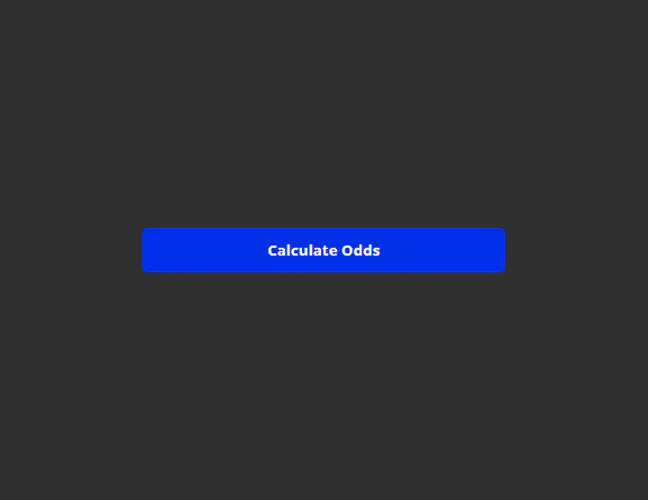
Click the ‘Calculate Odds‘ button to calculate poker odds and see odds of you winning.
What Types of Poker Games Are Available With Odds Calculator
Our poker odds calculator supports a variety of poker games, including:
- Texas Hold’em;
- Omaha;
- Omaha Hi-Lo;
- 7-Card Stud;
- 7-Card Stud Hi-Lo;
- Razz.
How to Improve Your Poker Game With an Odds Calculator
Using a poker odds calculator can significantly improve your game. Here’s how it works:
- Decision-making assistance: The calculator is a valuable option that will allow you to change the game strategy in time, adjusting it to specific game conditions;
- Odds of winning: This option will allow you to soberly assess your chances of winning hand;
- Bluff: Determine the right moments to bluff by evaluating the potential strengths of your opponents’ combinations.
What Else an Online Poker Odds Calculator Can Help
In addition to the above advantages for improving the game, this free Poker Calculator can also help in the following:
- A learning tool: This is an excellent educational resource for understanding the power of different poker hands at different stages of the gameplay;
- Scenario analysis: With this resource, players will be able to try out different game scenarios and test them in practice;
- Improve your performance: Track your progress on different game strategies.
Poker Hand Odds Charts
Various auxiliary resources, such as tables, can be incredibly useful during a gaming session or during the preparation stages for it. Here are two important odds charts that you need to have on hand:
Probability of Improvement After the Flop
| Flop Hand | Improved Hand | Outs | On Turn/River | On River Only |
|---|---|---|---|---|
| Open ended Straight Flush draw | Straight/Flush/Pair | 21 | 72.32% | 47.73% |
| Open ended Straight Flush draw | Straight/Flush | 15 | 54.10% | 32.60% |
| Inside Straight | Straight/One Pair | 10 | 38.40% | 21.70% |
| Four Flush | Flush | 9 | 35% | 19.60% |
| Open ended Straight draw | Straight | 8 | 31.50% | 17.40% |
| Three of a kind | Full House | 7 | 27.80% | 15.20% |
| Unmatched pocket cards | One Pair | 6 | 24.10% | 13% |
| One Pair | Two Pair/Three of a kind | 5 | 20.40% | 10.90% |
| Two Pair | Full House | 4 | 16.50% | 8.70% |
| Inside Straight | Straight | 4 | 16.50% | 8.70% |
| One Pair | Two Pair | 3 | 12.50% | 6.50% |
| Pocket Pair | Three of a kind | 2 | 8.40% | 4.30% |
| Three of a kind | Four of a kind | 1 | 4.30% | 2.20% |
Common All-in Hand Combinations
| All-In Hand 1 | All-In Hand 2 | Probability |
|---|---|---|
| AK | 76 suited | AK wins 60% |
| AK | QJ | AK wins 64% |
| AK | 22 | 22 wins 51% |
| AK | KQ | AK wins 73% |
| AK | AA | AA wins 87% |
| AK | KK | KK wins 66% |
| AQ | KQ | AQ wins 70% |
| AQ | QJ | AQ wins 70% |
| AQ | KJ | AQ wins 60% |
| AT | KQ | AT wins 58% |
| AA | KK | AA wins 80% |
| AA | 22 | AA wins 80% |
| AA | 76 suited | AA wins 77% |
| A2 | JT | A2 wins 55% |
| KK | K2 | KK wins 94% |
More About Calculating Poker Hand Odds
It is important for any serious poker player to understand how to calculate odds on combinations. In this sense, our Texas Hold Calculator is a very valuable tool. It will provide gamlers with valuable statistics and allow them to feel more confident during the game.
However, remember that the calculator does not have accurate data on the position of your opponents. That is why it is necessary to train your skills, learn poker rules and analytical abilities. Your experience and our poker calculator are two components of potential success!
Pot Odds or Implied Odds and More
Other valuable poker tools will also help players to make decisions at the poker table, namely:
- The Pot Odds are the ratio of the current size of the pot to the value of the expected bet;
- Implied Odds is a tool that estimates the total amount you can win in future rounds. This is especially useful when you need to decide whether to continue the game;
- Reverse Implied Odds takes into account the potential losses that you may incur if you make your hand, but still lose to a stronger one;
Hand Equity is your share of the pot based on the probability of winning your current hand.
Poker Odds FAQs
What are poker odds?
Poker odds are the probability of winning a combination based on the current cards and the remaining cards.
What is the best poker odds calculator?
The best poker odds calculator is the one you can find on the Pokerlistings website.
How does a poker odds calculator online work?
This tool calculates the probability of winning a particular hand by analyzing the entered cards.
What are good poker odds?
Good poker odds indicate a high probability of winning a hand compared to the risk of losing.
How to learn poker probabilities quickly?
Use poker odds calculators and study the hand charts to familiarize yourself with the main probabilities.
Are odds calculators allowed in online poker?
Yes, you can use this auxiliary tool during the online gaming process at any poker site.
How to quickly calculate poker hand win percentage?
For a quick result, use the Pokerlistings calculator. Just enter your hand and other data and see the odds.
What are pot odds and outs in poker?
The Pot Odds are the ratio of the pot size to the bet size. Outs are the cards that can improve the hand.
Can a poker odds calculator help me win more?
The calculator will help you improve your poker experience and strategy, but it cannot guarantee permanent winnings. Rely on your strategy and skills and see poker as a way of entertainment.
Do poker odds change when the number of players increases?
Yes, the odds of winning a hand decrease as more players are involved.
How much time should I spend studying poker probabilities?
Take time regularly to study probabilities and use tools such as Odds Calculators to improve your skills.
Can a poker equity calculator improve my game?
Yes, by helping you understand your equity in various situations.
What else can I do to improve my chances of winning?
Learn different poker strategies, practice regularly, and use tools like the Odds Poker Calculator to improve your skills.




User Comments
Not getting a “Get odds” button on your calculator.
@Steve: I just just tested on multiple browser, works fine for me. There’s a blue “calculate odds” at the bottom left. Could you be running an ad blocker that might interfere with the calculator?
The odds are wrong on the chart about unpaired cards improving to a pair on the flop. It says the chances to improve to a pair are 24% on the flop and 13% on the turn. This can’t be right because the turn is one card. So there is a 13% that you will make a pair with each card and since the flop has 3 cards then the chances are 39% not 24%. That or the 13% is wrong. It also to take your outs and multiply it by 2 for each street. So if you have 6 outs and multiply it by 2 is 12 and you have chances so that would 36%. So the odds of making a pair are closer to 36% or 39% than 24%.
Thanks for your comment, Jake. We could see why the confusion as we even had some people in the team confused, so we have re-worded the columns. The table shows the percentages of improving your hand AFTER the flop, so either on the turn or the river, or the river only.
PokerListings Team